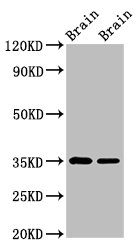
Western Blot Positive WB detected in: Rat brain tissue, Mouse brain tissue All lanes: Egln3 antibody at 3.6microg/ml Secondary Goat polyclonal to rabbit IgG at 1/50000 dilution Predicted band size: 28 kDa Observed band size: 35 kDa
Egln3 Antibody
CSB-PA14797A0RB
ApplicationsWestern Blot, ELISA
Product group Antibodies
ReactivityMouse, Rat
TargetEgln3
Overview
- SupplierCusabio
- Product NameEgln3 Antibody
- Delivery Days Customer20
- ApplicationsWestern Blot, ELISA
- CertificationResearch Use Only
- ClonalityPolyclonal
- ConjugateUnconjugated
- Gene ID112407
- Target nameEgln3
- Target descriptionegl-9 family hypoxia-inducible factor 3
- Target synonyms2610021G09Rik, Hif-p4h-3, Phd3, SM-20, prolyl hydroxylase EGLN3, HIF-PH3, HIF-prolyl hydroxylase 3, HPH-3, hypoxia-inducible factor prolyl hydroxylase 3, prolyl hydroxylase domain-containing protein 3
- HostRabbit
- IsotypeIgG
- Protein IDQ91UZ4
- Protein NameProlyl hydroxylase EGLN3
- Scientific DescriptionCellular oxygen sensor that catalyzes, under normoxic conditions, the post-translational formation of 4-hydroxyproline in hypoxia-inducible factor (HIF) alpha proteins. Hydroxylates a specific proline found in each of the oxygen-dependent degradation (ODD) domains (N-terminal, NODD, and C-terminal, CODD) of HIF1A. Also hydroxylates HIF2A. Has a preference for the CODD site for both HIF1A and HIF2A. Hydroxylation on the NODD site by EGLN3 appears to require prior hydroxylation on the CODD site. Hydroxylated HIFs are then targeted for proteasomal degradation via the von Hippel-Lindau ubiquitination complex. Under hypoxic conditions, the hydroxylation reaction is attenuated allowing HIFs to escape degradation resulting in their translocation to the nucleus, heterodimerization with HIF1B, and increased expression of hypoxy-inducible genes. ELGN3 is the most important isozyme in limiting physiological activation of HIFs (particularly HIF2A) in hypoxia. Also hydroxylates PKM in hypoxia, limiting glycolysis. Under normoxia, hydroxylates and regulates the stability of ADRB2. Regulator of cardiomyocyte and neuronal apoptosis. In cardiomyocytes, inhibits the anti-apoptotic effect of BCL2 by disrupting the BAX-BCL2 complex. In neurons, has a NGF-induced proapoptotic effect, probably through regulating CASP3 activity. Also essential for hypoxic regulation of neutrophilic inflammation.
- ReactivityMouse, Rat
- Storage Instruction-20°C or -80°C
- UNSPSC41116161
